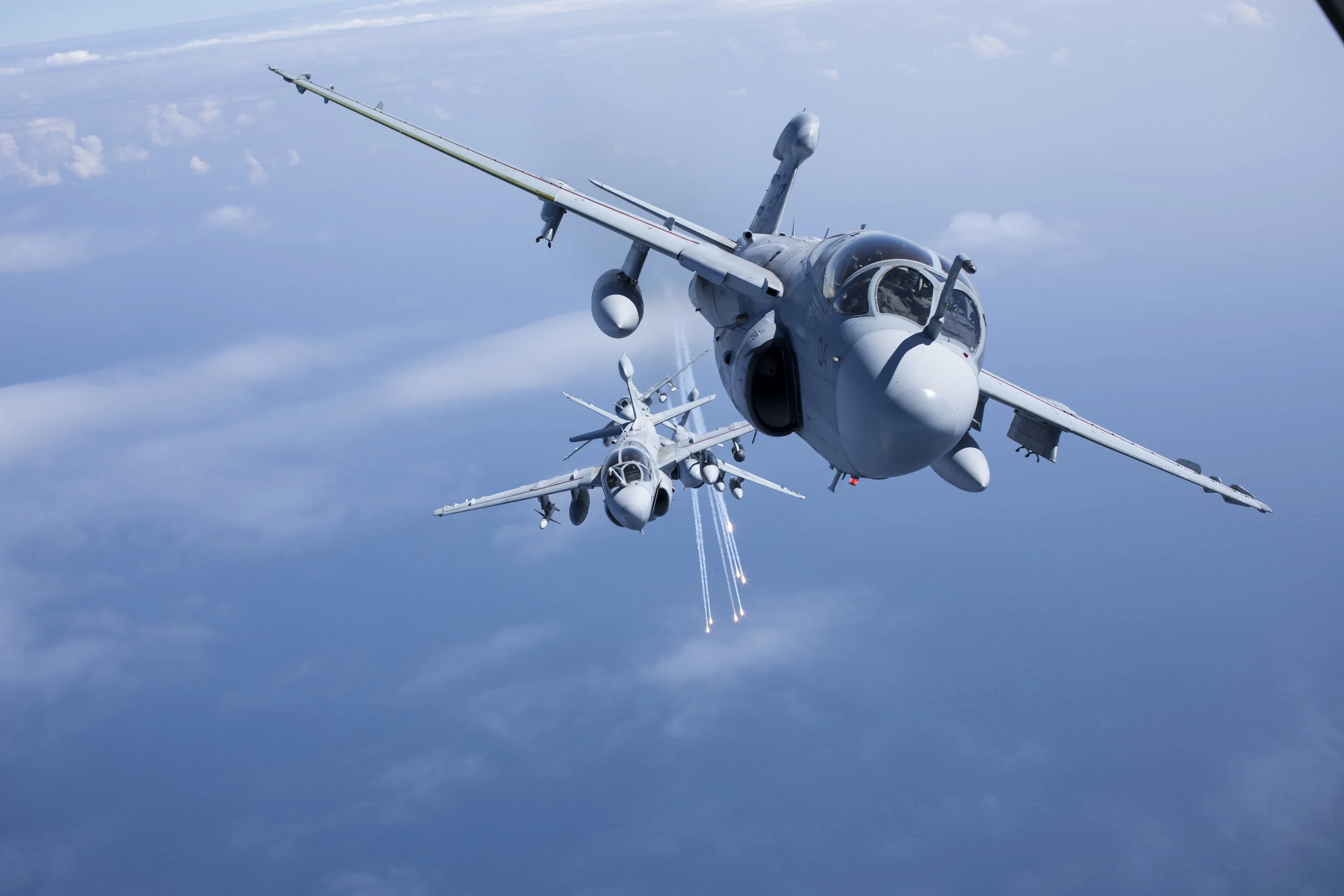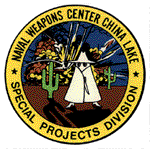AIRCRAFT SYSTEMS
China Lake has throughout its history been involved with the complete weapon system, which includes the necessary fire-control, interfaces, launchers, and (more recently) software. Beginning in the '40s, China Lake developed bomb directors such as the Mk 6 Mod 3, Mk 10, and the EX-1--the most accurate of its day for single-seat attack aircraft; the bomb-director set AN/ASB-8; and fire-control systems Mk 8, Mk 16, and EX-16--a high-performance system using a revolutionary computing technique. China Lake was involved in the early development of TV-based avionics, and following its early work on FLIR technology, China Lake was the lead in integrating FLIR systems into aircraft. China Lake targeting and fire-control projects also include the CP-741/841 weapons computer, Navy Pave Knife laser designator, and the Angle-Rate Bombing System (ARBS).
F/A-18 Hornet firing AIM-9 Sidewinder; China Lake's mission-avionics efforts have ranged from electromechanical bomb directors to software-intensive hybrid systems, integrated targeting/nav/EW suites, training devices, and operational flight programs (OFPs).
FLIR-equipped A-7 Corsairs dropping Snakeyes (unretarded) on China Lake target range; the A-7E WSSA, which began as a Fleet- support project and an avionics "brush-up," became the prototype for aircraft-weapons integration and avionics software activities.
As an outgrowth of its fire-control work, China Lake became involved with avionics and software development and weapons integration for the A-7 aircraft, and as a result of the great success of the A-7 project China Lake was designated the Weapon System Support Activity (WSSA) for the AH-1, A-4M, A-6E, A-7E, AV-8B, and F/A-18 aircraft and has performed integration and avionics tasks for a variety of other Fleet and developmental aircraft. Aircraft weapons integration and avionics, including the development and testing of operational flight programs (OFPs) has become one of the major areas of endeavor at China Lake. The Weapon System Support Facility at Armitage Field houses simulation and development laboratories that support every aspect of avionics hardware and software integration, development, and T&E.
Operator and cockpit controls/displays in the A-7E Simulation Laboratory at Armitage Field during systems-integration-software testing; China Lake developed its first Weapon System Support Activity (WSSA) for the A-7.
Aircraft fire-control simulator, Michelson Laboratory, 1949; development of bomb directors and fire-control systems and technology (including IR, electro-optical, and radar) at China Lake lead to such programs as Sidewinder, Walleye, and FLIR systems.
Outgrowths of China Lake's work in aircraft systems have included such support devices as the Memory Loader/Verifier and the development of the Versatile Training System/Versatile Computing System, which became the standard readiness-squadron training-support system and the basis for other training systems.
AIRCREW SAFETY
China Lake has been significantly involved in aircrew safety RDT&E since the 1950s when it developed the Rocket-Assisted Personnel Ejection Catapult (RAPEC). RAPEC was developed as an outgrowth of China Lake expertise in propulsion systems and was widely fielded. Another ejection seat based on China Lake propulsion-system expertise was the Vertical-Seeking Subsystem (VSS) for the Maximum-Performance Ejection Seat; although the overall program was cancelled in 1982, China Lake had developed and demonstrated the thrust-vector-control and MICRAD attitude-reference systems that allowed safe ejection at low altitude and in adverse attitude--even upside-down. Realistic, high-speed testing of ejection systems has also been a major area of T&E work at China Lake, especially using the SNORT dual-rail supersonic track, which was the test facility for most of the Navy's aircraft-ejection systems, as well as for several Air Force aircraft and the Gemini spacecraft.
SNORT supersonic-track test of the Rocket-Assisted Personnel-Ejection Catapult (RAPEC) ejection seat; an outgrowth of in-house propulsion expertise, NOTS designed and developed RAPEC in the mid- and late-'50s, beginning a lasting relationship between China Lake and aircrew safety; RAPEC was highly successful in the Fleet.
Naval Test Parachutist during qualification jump at China Lake; in 1979 China Lake became the Navy site for RDT&E of canopies and associated gear, including downsized harnesses for female aircrew, emergency (ejection-seat) 'chutes, special-forces staged parachutes, and the Space Shuttle emergency-egress system.
The 1979 incorporation of the National Parachute Test Range mission into NWC brought long experience and unparalleled expertise in parachute systems RDT&E to China Lake. Recent projects in aircrew safety and parachute systems have included the Seawater-Activated Release System (SEAWARS); the Space Shuttle Emergency Egress System; and T&E programs for special-forces parachutes, the Galileo Jupiter probe parachute system, and the recovery system for the Shuttle boosters.
Vertical-Seeking Seat (composite photo) during testing at SNORT Facility; VSS, designed as part of the cancelled Maximum Performance Ejection System, was an outgrowth of China Lake propulsion technology initiatives.
OPERATIONAL SUPPORT
Operations analysis in support of the weapons-development program has been a significant and very productive area of endeavor at China Lake since shortly after its establishment. R&D requirements, weapon system requirements, operations, intelligence, foreign-material exploitation, systems effectiveness, aircraft survivability, mission-area analysis, and systems alternatives studies have all been pursued. The Polaris Studies and the Free-Fall Weapon Studies are examples of analyses with significant Navy-wide impact. China Lake has also made extensive contributions to Joint Technical Coordinating Groups, Joint Munitions Effectiveness Manuals, and projects such as the Tactical Air Armament Study (TAAS). For example, as a result of TAAS, China Lake developed the Navy and Marine Corps Ordnance Requirements (NAVMOR) and the Soviet Ship Vulnerability Program for the Navy. One of the more significant pieces of analysis conducted by China Lake was the investigation of the 1973 munitions-train explosions at Roseville, Calif., and Benson, Ariz.; the Roseville-Benson Studies not only saved the Government $50,000,000 to $90,000,000 in damage claims, they established that Navy ordnance was, indeed, safe to ship by rail.
Sea Chaparral firing; China Lake modified the Army's Chaparral (Navy AIM-9D Sidewinder modified for surface-launch) system for shipboard use and fielded it in record time in 1972 in but one example of the quick-response capability of a full-spectrum in-house laboratory.
F4U Corsair loaded with 6.5-Inch Antitank Aircraft Rocket, Ram; responding to the urgent need to defeat new Soviet armour, China Lake designed, developed, tested, documented, pilot-produced, and delivered Ram to the operators in Korea in one month in 1950.
Throughout the Vietnam war, China Lake supported the operators through the Vietnam Laboratory Assistance Program (VLAP), providing analyses, weapons, support equipment, and operational support--including sending China Lake civilian personnel to provide immediate, on-sight consulting and liaison. China Lake provided customized direct support for the Special Forces community with special-warfare systems and swimmer weapons--everything from non-irritating face-paint sticks to plastic wrap to specialized weapon systems, night-vision devices, and liquid explosives. China Lake also developed major systems for special warfare, such as the Mk IX swimmer-delivery vehicle, the Underwater Explosive Unit, and the Actuation Mine Simulator.
Special weapons, small arms: Some of the special-warfare weapons developed by NWC to support SEAL team operations in Vietnam; the SEALs came to China Lake for weapons, night-vision devices and signals, support equipment, and even swimmer-delivery vehicles.
Special purpose small arms
Special Projects Logo
The quick-response capability of the in-house laboratory has proven to be one of China Lake's most significant contributions to the Navy and to the Nation over the years. Things like Project Ram, which developed, produced, and delivered the 6.5-inch tank-killing rocket to Korea in just 28 days in 1950; the ESE ("Easy") program that produced preproduction Shrikes for possible use during the Cuban Missile Crisis; literally hundreds of rush projects carried out under VLAP; development of a specialized TDD for Standard ARM; deployment of the Sea Chaparral and Shrike-on-Board systems for ship self-protection during Vietnam; development of the ICWD radar-warning device during the Iran crisis; and dozens of projects--large and small--in support of operations in Desert Shield and Storm.
Radio gear
SEAL TEAM equipment
China Lake FAE introduction team, South Vietnam, 1970; under VLAP and other programs, China Lake provided direct support to the operating forces, sending civilian engineers, analysts, and technicians to the ships on Yankee Station and to the operators in the field to introduce new weapons and to bring the operators' needs back to the lab.
One of the many huge explosions of the munition-train disasters at Roseville, Calif., and Benson, Ariz.; vast expertise in ordnance and energetic materials allowed NWC to conduct studies that proved that railyard and boxcar fires caused the explosions and that Navy ordnance was safe to ship by rail--and saved the taxpayers untold millions of dollars in damage claims.
One of the earliest results of the Free-Fall Weapons Studies, the Hawkeye cluster weapon (the banded mandrel--internal structure--shown here); the submunitions were modified 2.75-inch rocket warheads, prompting the name change to Rockeye I, which was cancelled in favor of the Rockeye II (still in service); China Lake's "Eye" series of free-falls was a direct result of the Studies.

















